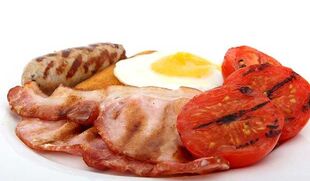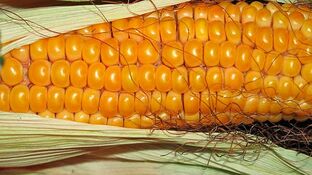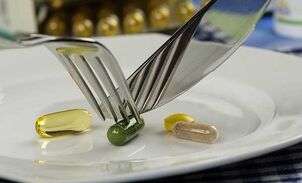 The ketogenic diet or ketogenic diet is a well-researched nutritional system that has been proven to be beneficial in many experimental and clinical studies.
The ketogenic diet or ketogenic diet is a well-researched nutritional system that has been proven to be beneficial in many experimental and clinical studies.
However, the architecture is complicated. Not for everyone, and there are many pitfalls.
What is the keto diet
This is a low-carb food with a high-fat menu. Similar to a regular no-carbohydrate diet or Atkins diet.
The carbohydrate content in the diet is significantly reduced, while the fat intake is increased, which will convert the body into ketosis.
Ketosis is a metabolic disease in which fat is the main source of energy for the body. This happens when the intake of carbohydrates (usually the main energy source) is minimized.
Ketosis occurs during fasting, pregnancy and infancy. It can be artificially induced in adults by switching to a high-fat and low-carbohydrate diet.
In ketosis, insulin levels drop. A large amount of fatty acids leave adipose tissue and enter the liver, where they are oxidized and converted into ketone bodies or ketones, which are a source of energy.
Formation:
- β-hydroxybutyrate, the main ketone body circulates in the blood;
- Acetoacetate-the main product of the liver;
In the absence of glucose, ketone bodies can cross the blood-brain barrier and supply blood to brain cells.
The ketogenic diet leads to a continuous decrease in insulin and sugar levels, which has a variety of beneficial effects on human health.What is the difference between ketosis and ketoacidosis
The ketosis caused by a carbohydrate-free diet is fundamentally different from diabetic ketoacidosis.
Non-diabetic patients have normal blood sugar levels. When the carbohydrate storage is exhausted, the liver will start producing glucose from other sources (pyruvate, glycerol and amino acids).
This can maintain normal blood sugar levels and ensure that the ketone body concentration is within 8 Mmole / L, which is safe for health.
In patients with type 1 diabetes, the level of ketones reaches 20 Mmol/L. This situation is life-threatening.

What is a keto meal: options
- Standard protocol. This means eating a lot of protein and fat, and minimizing carbohydrates-no more than 50 grams per day. The menu includes 75% fat, 20% protein and 5% carbohydrates.
- High-protein ketone diet. It is the same as the standard plan, but with more protein. 60% fat, 35% protein, 5% carbohydrate.
- Loop options. In this diet, after 5 days it is a standard diet and 2 days is high carbohydrate. Reminiscent of the BUCH diet.
- Targeted methods. They eat according to a ketogenic plan and consume carbohydrates before and after training.
All scientific research conducted has only evaluated the standard version.
Cycles and targeted methods are only used by athletes (mainly bodybuilders). These diets do not help lose weight or improve health.
How the keto diet affects weight loss
Scientific evidence shows that this is an efficient way to lose weight, and it provides more consistent results compared to traditional low-fat weight loss systems that require strict calorie restriction.
Studies have shown that those who lost weight on a ketogenic diet lost 2. 2 times their weight and were volunteers who strictly controlled calories on a low-fat diet.
The mechanism of weight loss in a keto diet is as follows.
- Eat a lot of protein, which is necessary for stable and healthy weight loss.
- Gluconeogenesis. Protein and fat are converted into carbohydrates. This process can burn more calories throughout the day.
- Suppress appetite. Ketogenic nutrition can normalize the levels of the hormones leptin and ghrelin, which is the cause of eating behavior.
- Increase insulin sensitivity. Insulin resistance leads to weight gain. Therefore, increased sensitivity to hormones speeds up metabolism and promotes the rapid breakdown of fat deposits, and reduces the rate of formation of new deposits.
Treatment and prevention of metabolic syndrome and type 2 diabetes

Metabolic syndrome is a metabolic abnormality that significantly increases the risk of obesity, type 2 diabetes and heart disease.
The sign that a person has metabolic syndrome is:
- Hang blood pressure;
- Abdominal obesity (big belly);
- High blood sugar (even if diabetes has not been diagnosed);
- Poor lipid profile indicators (rules of cholesterol self-decoding analysis).
Through lifestyle and diet changes, such as switching to a keto diet, all these indicators can be improved without the use of drugs.
- Improving the sensitivity of human cells to the hormone insulin plays an important role in the treatment and prevention of diabetes and metabolic syndrome. Using a keto diet increased insulin sensitivity by 75%. Some people with diabetes may even stop taking medication.
- Improved lipid distribution index. Positive changes affect cholesterol and triglyceride levels.
- Ketone bodies provide extra support for the body, and ketone bodies themselves have beneficial properties.
What other therapeutic effects does the keto diet have?
- Help treat epilepsy. A recent meta-analysis of 70 clinical studies found that the keto diet can reduce the number of seizures by 50% in 46-62% of cases. The exact mechanism of the anticonvulsant effect in the diet has not been established. Scientists believe that this positive effect may be related to the increase in the amount of the antioxidant glutathione in the mitochondria and the increase in the effect of the inhibitory neurotransmitters GABA and adenosine.
- Alzheimer's disease treatment. Several small studies have shown that keto nutrition can improve the condition of patients with mild Alzheimer's disease. In patients with this disease, the brain's glucose supply is impaired. Ketone bodies can provide energy for the brain without the participation of glucose, while reducing the toxic effects of glutamate.
- Supports patients with Parkinson's disease. According to some studies, a carbohydrate-free diet is beneficial to patients with Parkinson's disease by preventing dopaminergic neuron death and mitochondrial damage.
- Help children with autism. It is speculated that the keto diet can improve the behavior of children with autism. It is more effective than the Atkins diet, gluten-free and casein-free foods. However, there is very little data on this issue, so they cannot be considered completely reliable.
- Cancer treatment. Tumor cells only act on glucose. They cannot get energy from ketone bodies. Therefore, the transition to ketogenic nutrition promotes cell death in malignant tumors. However, experts emphasize that this method can only be used in combination with chemotherapy and requires a doctor's permission. And don't put too much hope on this method.
- Improve skin condition. Especially to eliminate acne. The diet requires low insulin levels and all industrially produced foods eliminated in the diet can eliminate chronic inflammation that affects the skin.
- Treatment of polycystic ovary syndrome. The disease is related to impaired glucose and androgen metabolism. The ketogenic diet helps restore the insulin sensitivity that plagues women with polycystic syndrome.
A note about the keto diet: food list

- Any form of sugar. Obviously, sweets (sweets, ice cream) and foods that do not seem sweet but contain this ingredient in their ingredients are also listed as prohibited foods. It may even be ketchup purchased in the store.
- Cereals: wheat (including spelling), rye, barley, rice, corn.
- Vegetable oils that make you fat-soybean, corn, sunflower, rapeseed. And trans fats.
- Fruit. Except for a few berries (such as strawberries).
- Beans. Beans, peas, lentils, etc. Can be used for green foods, such as beans.
- Tubers and rhizomes. Potatoes, carrots, beets, parsnips, etc.
- Any "diet" food, such as low-fat cheese (in this type of product, fat is replaced by sugar).
- Products containing sweeteners in the form of sugar alcohols (xylitol, erythritol)-have a negative effect on ketone bodies.
- Dip and seasoning, sugar, starch, flour are used in the preparation.
- Alcohol.
- All finished products produced in the food industry.
The ketogenic diet: what you can and should eat
- All meats: beef, pork, poultry, lamb, etc.
- Fish and seafood.
- Eggs.
- Vegetables. Preferably it is green. Other foods (tomatoes, eggplants, onions, sweet peppers) are allowed-mainly with a lot of fiber and actually no digestible carbohydrates.
- Fatty dairy products-cream, butter, cheese.
- Nuts and seeds.
- Mushrooms.
- The right vegetable oils: olive oil, coconut oil, avocado.
- Fermented foods: natural yogurt, kefir, sauerkraut, etc.
- Spices and herbs.
A sample menu for men and women who have a ketogenic diet every week
| Monday | Tuesday |
Breakfast: scrambled eggs with bacon and tomatoes. Lunch: broccoli and broccoli soup in chicken broth, chicken fried with eggplant and green pepper. Dinner: A piece of red fish grilled with sour cream and vegetable salad. Breakfast: Fat-free natural yogurt, no sweeteners or flavors with nuts and/or seeds. |
|
| Wednesday | Thursday |
Breakfast: scrambled eggs and sweet peppers. Lunch: fish soup (no potatoes), pork chop stewed with mung beans. Dinner: Grilled chicken breast with sour cream, cucumber and tomatoes. Breakfast: ordinary fat cheese without sugar and spices. |
|
| Friday | Saturday |
Breakfast: boiled eggs and a piece of cheese. Lunch: Sour cabbage soup (no potatoes added), chicken liver stewed in sour cream and fried onions, and white rat noodles. Dinner: Salad with fish and/or seafood (no potatoes and rice), but green vegetables, tomatoes, etc. Breakfast: cheese and herbs. |
Breakfast: cheese and herbs. Lunch: bone broth with meatballs (no flour or bread), beef anthurium and cabbage stew (fresh or sour). Dinner: boiled chicken, radish and cucumber salad. |
| Sunday | Move to next week |
Breakfast: scrambled eggs and feta cheese. Lunch: Vegetable soup with broccoli and broccoli (no potatoes), whole oven grilled chicken, cucumber and tomato salad. Dinner: mushrooms, sour cream stew and vegetable salad. |
Repeat the first week, trying to add more variety to the menu. There are many recipes to meet the needs of the keto diet. |
Rules to follow
- You can and should be full without calories.
- Only eat the correct fat. This means that only oils that can withstand heat treatment are allowed for cooking. Only use the correct dietary ingredients to lubricate the salad.
- There should be a lot of fat in your diet. You cannot focus on protein.
- Tea, coffee, instant chicory and many other beverages are allowed. The main selection criterion is that the beverage does not contain sugar and sweeteners.
- You should try to put a lot of spices in your food.
Healthy snacks while losing weight through a ketogenic diet
Since the ketogenic diet does not require calorie counting, not only is it allowed or even snacks. But they must be correct.
Allowed:
- boiled eggs;
- Meat slices;
- cheese;
- Nuts, seeds and various pastes and oils made from them;
- Berries, such as strawberries with cream (but you should not be taken by the berries);
- Natural yogurt and other natural fermented dairy products;
- All vegetables allowed in the diet and light salads from vegetables.
All dairy products, whether cheese or yogurt, should have normal fat content.
What is "keto flu": symptoms
The first few days of switching to a low-carb diet can be difficult. Unpleasant symptoms are usually observed, called "keto flu".
may be tagged:
- Continuous hunger, especially the craving for sugar;
- Tired;
- Insomnia;
- Abdominal discomfort, stomach pain;
- Nausea and vomiting; Constipation or diarrhea;
- Difficult to concentrate;
- Headache and dizziness;
- Muscle pain and cramps;
- Irritable and crying.
How long does ketoflu last?
From days to weeks. The use of fat as the main fuel source is related to the reorganization of the body. When adapting, energy may be insufficient, resulting in the unpleasant symptoms listed. But they do not pose any danger.
Ketone bodies are always present in small amounts in the blood. After the first 2-3 days of a strict no-carbohydrate diet, the liver begins to produce ketones, and their blood levels rise to 2-3 mM.
When cells in a carbohydrate starvation state reduce the absorption of ketones from the blood, increasing their concentration to 8 mM, the adaptation is complete. At this point, effective ketone transport through the blood-brain barrier begins.
It is not clear why some people adapt easily to a ketogenic diet, while others find it difficult. Assume that a person’s eating habits are important. The easier it is to digest the carbohydrates he consumes, the more difficult it is to transform. Genetic susceptibility is important.
How to quickly enter ketosis through a keto diet

- The correct way to drink water. When carbohydrates are removed from the diet, the storage of glycogen in the body decreases. As glycogen accumulates water around itself and decreases in quantity, dehydration may occur, which can lead to fatigue and muscle pain.
- Only light exercise. During the adjustment period, only light exercises are allowed: walking, yoga, slow cycling. Must give up all kinds of strenuous fitness.
- Recommended mineral supplements:
- Sodium-3-4 grams per day;
- Potassium-1g;
- Magnesium-0. 3g.
also shows supplements containing creatine monohydrate and caffeine.
The specific smell of ketone breath and urine
The transition to a fat-rich, non-carbohydrate diet is usually accompanied by the appearance of specific odors in the mouth. This person himself often feels a metallic taste in his mouth. People around you usually see it as the smell of nail polish remover. Some people think it smells like fruit. Urine will absorb the same smell.
This phenomenon is caused by the formation of volatile acetone, which is often found in nail polish removers.
The smell is not a side effect. It just shows that the body is transforming to work with fat and form ketone bodies. Harmless to health. But this may make people uncomfortable for themselves and those around them, especially when breathing.
To reduce the severity of your symptoms, you need:
- Drink plenty of water;
- Eat less protein;
- Use mint gum;
- will slightly increase the carbohydrate content (only if you consume less than 50 grams per day).
After 1-2 weeks, the smell should disappear on its own.
Delayed side effects of the keto diet
In addition to ketoflurane, which subsides within a few weeks, this diet regimen can also cause delayed side effects. Possibly:
- Digestive system problems caused by excessive intake of fat and intestinal flora dysfunction;
- Cholesterol level gradually rises;
- Increase the burden on the kidneys, which may increase the possibility of renal failure and cause urolithiasis;
- Decreased bone density.
Potential nutritional deficiencies of long-term ketogenic diet

Since the diet cannot be called a balanced diet, long-term intake of this diet will result in a lack of certain important ingredients.
- Calcium. Stay in the urine. Because of the excess fat, the urine becomes too acidic, so the body has to alkalize it with calcium. In addition, the lack of carbohydrates will impair the absorption of this trace element.
- Magnesium. According to the hypothesis, the gradual development of deficiency is related to foods rich in this trace element in the diet-grains and fruits.
- Iron. Too much fat in food can impair iron absorption.
- Sodium and potassium. As insulin levels decrease, the loss through the kidneys increases. However, unlike other micronutrients (such as calcium or magnesium), the deficiency of potassium and sodium will disappear quickly over time. And in many ways, their shortage is due to the gradual disappearance of the symptoms of keto flu.
- Selenium. The deficiency may be due to the lack of this trace mineral in fatty foods. Brazil nuts are an exception, one of which makes the body consume 100% of selenium every day.
- Carnitine. The disadvantage is that the compound is consumed too quickly in a fat diet.
If you are on a keto diet for a long time, you should regularly check the levels of all substances that may become insufficient over time. It is recommended to take dangerous nutritional supplements.
Who should not switch to keto foods: contraindications
- Children, pregnant and breastfeeding women, diabetes and cancer patients can switch to a ketogenic diet only under the guidance and supervision of the attending physician.
- People with genotypes ApoE3 and ApoE4 are prohibited from eating because it can cause life-threatening cholesterol levels.
- Don’t follow epilepsy patients with KCNJ11 and BAD genes.
- Severe liver and/or kidney disease is a contraindication to following this diet plan.
Conclusion
The keto diet is a very strict nutritional system that requires almost complete elimination of carbohydrates and the introduction of large amounts of fat in the diet.
Switching to a ketogenic diet is usually unbearable.
The diet plan has received a lot of scientific research, many of which have proved its benefits for weight loss, treatment of type 2 diabetes and neurodegenerative diseases, normalization of lipid distribution and elimination of metabolic syndrome.
However, few studies have evaluated the health effects of long-term (more than one year) dieting. Moreover, according to certain assumptions, the continued existence of this diet may be harmful to health.































